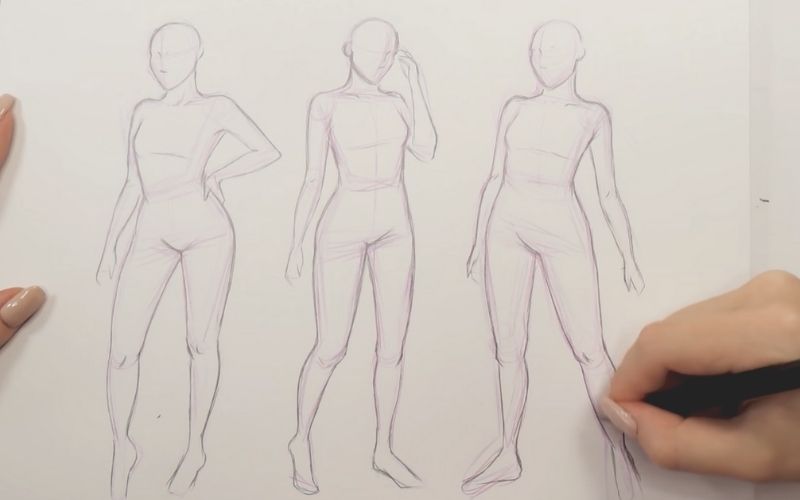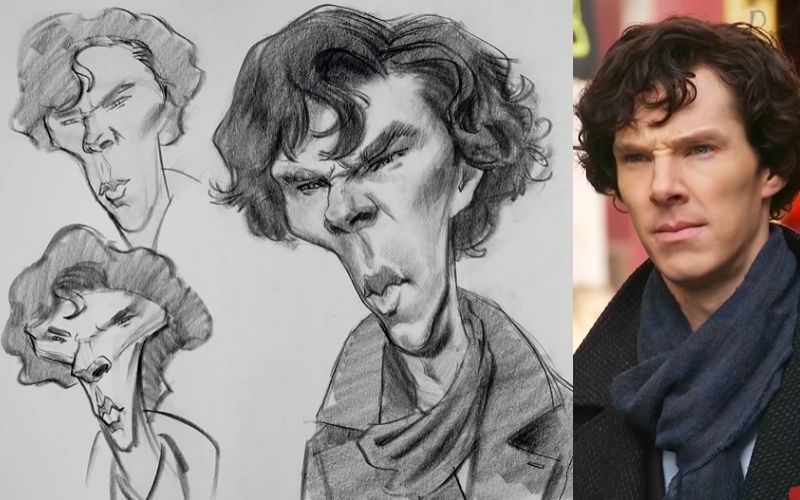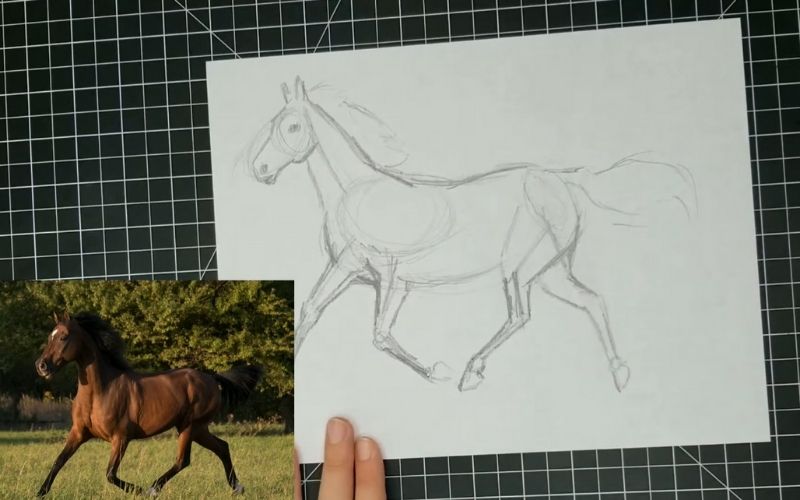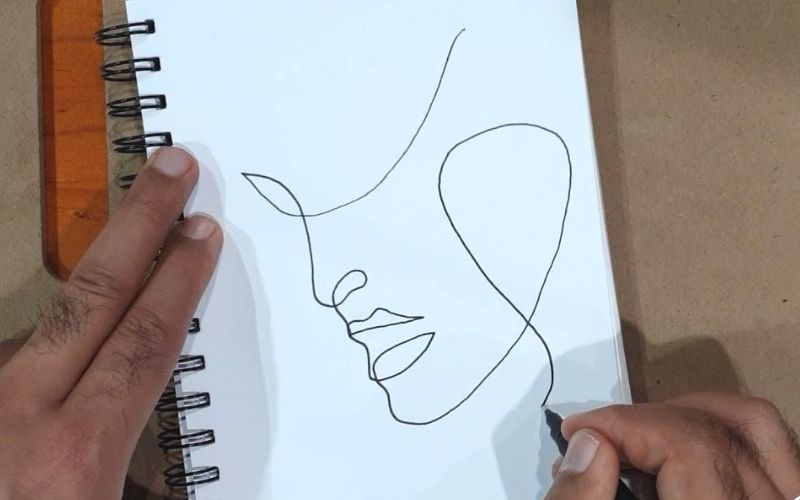30 Cool Sketch Ideas When You Take On A 30-Day Creative Challenge

Sketching is a great way to relax and have some artistic fun. It's also a fantastic way to improve your drawing skills. When you're in the mood to put pen to paper, it can be tough to decide what to draw. We've put together this list of 30 cool things to sketch to give you more ideas! We've also included tips to keep your momentum going, especially when you feel like taking on a 30-day sketching challenge.
Parts to Practice
Sketching is a perfect way to improve your drawing skills. It is fun and free to do, and you can do it almost anywhere. However, constant practice makes perfect, so here are a few challenging parts you need to take on individually to improve your drawing technique.
1. Eyes

Sketching anime eyes - Image by Rain
Whether they're for anime or realistic drawings, the eyes are important in conveying the emotion you want to show. Here are some anime drawings of male and female eyes to use for practice. If you wish to make them look more realistic, try this eye drawing tutorial using graphite.
2. Human Hair

Sketching realistic human hair - Image by RapidFireArt
Drawing hair is difficult, but it's essential to learn how to do it properly. You want to make sure you capture the flow and movement of the hair, especially the individual strands. Sketching hair needs patience, attention to detail, and an understanding of values and tones. If you're into anime, try this tutorial for different hair types.
3. Facial Expressions

Sketching facial expressions - Image by Emirichu
Facial expression is another important factor when drawing. Animals and people have different facial expressions, depending on their emotions. Sketching anime is challenging since you only have the eyes, mouth, and eyebrows to play with to express emotions.
Unlike realistic drawings that you can play on other features, anime has limited facial features, so maximize what you can. Steady practice is a must.
4. Head Angles

Drawing the head from different angles - Image by Kuzomari
When drawing people (and even animals), you don't draw them from a single vantage point. Learn how to draw the head from different angles with this tutorial. Proper head angling is also one way to capture facial expressions.
5. Drawing The Body

Drawing the body - Image by Natalia Madej
We come to the part that some newbie artists miss, mainly if they focus on portraits. However, drawing the body is essential, especially in fashion design or comic book illustrations. These drawings include how to proportion the torso, legs, and arms with the rest of the body.
6. Angles and Proportions in Figure Drawings

Angles and proportions in figure drawings - Image by Zoe Hong
Understanding how the human figure works effectively makes proportions and angles on your figure drawings. Find a good reference image, preferably in body-hugging suits, to see the lines better. This tutorial is very detailed and easy to follow. You're sure to master body proportions and angles so you can draw better.
7. Gesture Drawing

A sketch of a woman's gesture - Image by The Virtual Instructor
Do you know why professional artists, whether realists, cartoonists, or animators, can capture how a person or animal moves? Because they understand their subject's gestures. Look how the artist drew the young woman's angles and lines. Sketching gestures help you master drawing people and animals in motion.
8. Drawing in Perspective

Drawing human figures in perspective - Image by David Finch
When you're drawing from a different vantage point than the viewer, understanding how to sketch in perspective (take into consideration the angles, proportions, and gestures of your figures) is important. Not only should some figures look small, but they also have to be in the correct planes so that when you look at them, you'll perceive that these figures are relative to the drawing.
9. Realistic Fur

Drawing fur - Image by Kirsty Partridge
Fur, like hair, is tricky to get right. When drawing an animal with fur, it's crucial to understand how the light hits the coat and creates different shades. Work in layers to create a realistic effect. Start with the direction of the fur, then add some shadows, and finally work on the highlights. It helps if you have a good reference image.
10. Strokes and Techniques

Examples of strokes and techniques for sketching - Image by Paint Academy
Have fun drawing these strokes and perfecting techniques for your drawing and sketching practice. You may find this drawing idea different, but mastering these strokes and techniques will allow you to make patterns, understand textures, and create an optical illusion in your drawings and sketches.
Anime & Cartoon Characters
Creating anime and cartoon characters is a lot of fun. They may look simple to draw, but still, they're challenging to do. Start practicing with a daily sketch to improve your drawing skills.
11. Anime Characters

Sketching an anime character - Image by Artiz Arif
Anime characters are one of the favorite subjects that even beginners love to draw. However, anime characters are not as easy to draw as you think. You'll see the stunned expression of this character by just looking at it. How? The size of the eyes, the height of the eyebrows, and even the mouth tell a story.
12. Cartoon Characters

Sketching a cartoon character - Image by Christopher Hart
Cartoon characters are distinct from anime characters by having exaggerated body parts, like overly large heads and tiny bodies. Other cartoon characters have proportionate body parts, but the drawing style is still distinguishable. Also, cartoon characters target younger audiences compared with anime.
13. Anime of Self

Drawing anime of self - Image by Laovaan
Draw an anime version of yourself from your selfie. Even without using a tool, you can still draw an anime self-portrait if you master angles, proportions, gestures, and other minor details that make a lot of difference in your drawing.
Movie & Comic Characters
Movie characters are another subject when you're bored or need some inspiration for your practice sketches. Choose your favorite movie characters and start sketching away.
14. Villains

Sketching Venom from Spiderman - Image by Frank Cho
Venom, as everyone knows, is a villain from Spiderman 3. This character is popular and makes a great practice sketch for comic book fans. Start by lightly drawing the basic shapes of his head and body. You can add the other details later.
15. Horror Characters

Sketching Pennywise from the movie It - Image by Cartooning Club How to Draw
Pennywise is a character in the horror movie "It" and is a perfect choice for practicing on your sketches. Getting the details on your drawing is essential, and if you can sketch him, you can do any other movie character you have in mind.
16. Protagonists

Caricature of Benedict Cumberbatch as Sherlock Holmes - Image by Proko
Aside from lookalike sketches of your favorite movie characters, you can also do a caricature. Caricatures are fun to make. The more distorted the images are, the more challenging it is. But once you get the hang of it, you'll see that it's pretty easy.
17. Mythical Characters

Mythical characters - Image by Jazza
Let your imagination run wild when you choose to sketch mythical characters, like this winged dragon. It's a great way to unleash your creative side and go beyond the ordinary.
Figure Drawings
18. Four-Legged Animals

Sketching 4-legged animals - Image by Modern Day James
Newbie artists usually avoid sketching animals because of proportion issues and other complexities. But with a bit of practice, you can quickly sketch out four-legged animals like dogs and horses. For a step-by-step guide on making cool drawings of animals, you may view this artist’s tutorial here.
19. Animals in Action

Sketching animals in action - Image by Prairie Moon Atelier
Sketching animals while at rest is one thing; sketching them while in motion is another. In this example, you have a range of muscles to contend with, the angle of the head, placement of legs, and even the spread of the mane and the tail.
Realist Drawings
Before sketching for realistic drawings, it is best to master figure drawings first. From there, you can progress to realistic drawing because you have a better grasp of proportion, angles, gestures, poses, and other important aspects to adapt a realistic style to your drawing.
20. Pets

Sketching a realistic dog - Image by Ali Haider
Your beloved animals also make an excellent subject for sketching. However, since they're very mobile, we recommend getting a good snapshot of your pet, such as a dog, to capture the details better. Practice detailing with fur, facial expression, and even their proportions to get a good version of your reference image on paper.
21. Realistic Portrait

Sketching a realistic portrait - Image by Dan Beardshaw
Sketching a realistic portrait may take you a while before you feel confident to do it, but it's a feat worth celebrating. We recommend starting with pencils before moving to pens when you're more adept at capturing details. Many artists find that using a blending stump improves the overall quality of their drawings.
Sketching Nature & Landscapes
One of the most beautiful things you can sketch is nature. Find a mountain, a tree, a flower, or a sunset that inspires you. To make your sketches look more realistic, use light and play with shadows to give depth and dimension to your artwork.
22. Mountain Landscapes

Sketching a mountain landscape - Image by Linescapes
Mountains are everyone's favorite subject. However, instead of drawing just the crest, identify the horizon, the textures, the surfaces, and other elements in your reference image to sketch it more accurately. Don't forget to highlight the foreground, mid-ground, and background to get a better feel of your drawings. If you want to focus on mastering your landscapes, try this artist’s starter guide.
23. Trees

Sketching trees - Image by Draw Awesome
You can explore so many ways, views, and angles with trees as your subject. To draw trees, start with the trunk, then build the foliage. Develop the foliage by adding texture and layers. Identify the light source to darken some parts and leave other parts lighter.
24. Lake Scenery

Sketching a lake scenery - Image by Drawing Academy
Sketching a water feature is a great way to practice adding reflections and highlights. When drawing a lake, start with the sky and add the mountains in the background. Work your way down to the water and sketch the different elements, including trees, rocks, and foliage.
25. Neighborhood scene

Sketching a neighborhood scene - Image by Shivam Art
Another good subject to draw is your neighborhood. If you're living on the farm, your neighborhood scene may be vast wheat fields, a rumbling river, or a barn. If you're in the city, you can sketch a street scene, cars on the street, or people going on with their busy lives.
26. Botanicals

A journal with sketches of leaves - Image by Shayda Campbell
If you're a gardening enthusiast, sketching botanicals is like taking a snapshot of your favorite plants, only better and more rewarding. You may also visit friends who have beautiful houseplants to draw or go to a public garden and start sketching.
Don't limit yourself to flowers. Explore the beauty of leaves, stems, and even the bark of a tree.
27. Potted Succulents

A doodle of potted succulents - Image by Doodles by Sarah
Doodling or sketching potted succulents or house plants is another good choice for a subject. Gather your succulents and start drawing them. Potted succulents are very rewarding to sketch, and they challenge you to get the details right no matter how small these cute plants are.
Pen Sketches and Drawings
Sketches don't have to be with pencils only. You can also do sketches with a ballpoint pen, micron pen, or even markers. Here are a few samples of what you can do with pens.
Using pens for sketching has several advantages - they don't smear or smudge, make clear lines, develop your confidence, and keep their quality for a long time.
However, you may have issues with ink flow during winter. Pens don't keep as long as pencils do, and your sketch may discolor if you use paper that is not acid-free.
28. One-line Drawings

One-line drawings - Image by GaganKataria aka GaganAstic
Explore your creativity by making sketches using straight lines and curved lines to create artwork. Draw cool things with just a line and discover where that single line can take you. You'll see how the artist carefully planned a single-line art to create a woman's sophisticated silhouette.
29. Romantic Moments

A couple sharing a romantic moment over coffee - Image by DrawingWiffWaffles
Moments captured on camera are also lovely to sketch. This guy hugging his girl while she enjoys her coffee is a nice gesture captured on camera, and this artist couldn't think of a better subject for her pen sketch.
The output may not be as clean as when you do it with pencils because you can't erase stray lines, but pen sketches have the rawness and allure that captivate many artists and their audience.
30. Portraits

Portrait of a Tibetan boy done in red pen - Image by DIYing Yang
Test your ability to create portraits using a pen. Drawing or sketching with pens challenges you to develop your confidence, just like the artists who did this portrait of a Tibetan boy.
Working with pens is tough since you cannot erase them, but it's worth trying. We don't recommend it to newbies because pens can be very unforgiving.
Tips When Sketching Using Different Medium
Sketching with Graphite Pencils
Graphite pencils are one of the best options to use when sketching. Here are a few tips for sketching with graphite pencils.
- Hold your graphite pencil with the pressure you want on your sketch. Holding near the end of the pencil makes light sketches, while holding closer to the sharpened end makes darker, controlled lines. For best results, keep your sketches light by using B graphite pencils.
- Use the correct type of paper. Paper with more tooth leaves a coarser finish than paper with a smooth surface.
- Master the hatching and cross-hatching on your sketches.
- Make use of the right tools for sketching. Keep your pencils well-sharpened and get a high-quality eraser.
Sketching with Charcoal Pencils
Before drawing with charcoal, you need to make a rough sketch of the reference image.
- When sketching with a charcoal pencil, decide whether to use a pencil, vine, or stick charcoal. Charcoal pencils are better for detailed lines, vine charcoal is best for lighter sketches, and stick charcoal is best for sketching large areas.
- Hold your charcoal as you would a regular pencil to outline the sketch, then use the wider part of the charcoal to darken or tone the other parts.
- Use your finger wrapped in a dry paper towel to smudge the charcoal to even out the tone.
- From here, you can continue your drawing. Don't forget to erase the stray lines on your sketch before finalizing the drawing.
- To avoid your work from smudging, add a sheet of glassine or wax paper in between sketches. Check out these charcoal drawing ideas for more inspiration.
Sketching with Ballpoint Pens
Here are a few tips for sketching using a ballpoint pen.
- Add light, gentle strokes using your ballpoint pen. If you have a reference image, you can start by sketching with a pencil, then go over it using the pen.
- Avoid smudging by working on the opposite side of your favored hand. For example, if you're right-handed, start drawing on the upper left side, then progress to the right.
- Let the ink dry well before touching it to avoid the ink from smudging, especially if you're using smooth paper.
- Use acid-free paper if you want to keep your sketches for a long time.
Tips to Keep You Motivated
Sketching takes practice, but it is a skill that anyone can learn with time and patience. If you're feeling up for a challenge, why not try a 30-day drawing challenge? Don't worry or feel frustrated. We have the tips to keep you motivated. Before you know it, you're ready to take on any art project.
1. Set a goal for yourself.
Whether improving your skills or trying new techniques, having a goal will help you stay focused. Picture what you want to achieve by the end of the 30-day challenge and focus on that goal.
For example, if your goal is to draw 100 heads in one month, sketch at least 3 heads a day. Keep your sketches in one place, preferably in a single sketchbook or art journal.
2. Start now.
One of the reasons why a creative person doesn't get enough motivation is not starting. Don't wait until you're inspired to start drawing. Get those art supplies and have a go. It doesn’t matter if you only have a pencil and a sheet of paper to begin with, but just start.
3. Set up an art space.
You don't need to build an expensive art studio to start drawing. You can designate a small corner space to be your art space. Put a small table in that corner and a comfortable chair.
Set this space near an open window for natural light. However, if you can't have that space, add daylight lighting near your workspace, preferably overhead.
4. Build a habit.
Like getting a new hobby, drawing is a habit you need to build. Set a daily schedule to sit in your art space and draw. Most professional artists have a set time to draw, sometimes spending 10 or 12 hours a day.
5. Squeeze out those juices.
Don't wait until you're "in the mood" to draw. If you wait, those juices may never come out. It might be too late when they do because you've already lost the moment.
Start with a squiggle or a doodle on your paper when you feel uninspired. It doesn't have to be perfect. Just get those creative juices flowing by putting pencil to paper. You'll discover some creative drawing ideas from those random doodles in no time.
6. Make a plan.
Download drawing prompts, then list them on your art calendar so you don't have to look for inspiration every day. Some art websites have monthly drawing prompts so you can update your art calendar every month.
7. Challenge yourself.
Most artists challenge themselves by posting their work online for accountability. For example, if you want to make a sketch a day, start a 30-day challenge on your social media profile and upload it.
Aside from getting better at your sketches, you'll also get comments that will help improve your sketching skills. Ignore negative comments that don't have a bearing on your skills, but take constructive criticisms from serious artists.
8. Join artists' communities.
Joining an art community is also a great way to keep you motivated. Get an art buddy to check in every day, whether online or in person. A buddy keeps you accountable to keep you motivated, especially if you're working on a challenge listed above.
9. Try a new style.
You may try other drawing styles like figures and gestures if you're into anime drawing. If you're into realism, try adding abstract elements to your drawings. You may even use a new medium to make cute drawings.
10. Don't be afraid to try again…and again.
Don't be afraid to start a new project if you think your drawings don't match the quality you want. Rather than spend hours deciphering what went wrong with your sketch, start a similar one and improve where you think you failed. Explore new ideas and find new things to draw.
11. Don't be too hard on yourself.
Remember, you're working on a sketch only. Whether you want to finish it or not is not a pressure. Sketching should be a fun way to discover new subjects and what you can do, so immersed in the fun without the burden of perfection.
Conclusion
Sketching is not only a fun and easy way to relieve boredom, but it can also improve your creativity and problem-solving skills. With the right attitude and mindset, you can produce great sketches quickly. Try enrolling in these online drawing classes.
